
Belgian collectors card by Kwatta, no. C. 306. Photo: MGM. Ann Miller in On the Town (Stanley Donen, Gene Kelly, 1949).

Dutch postcard by Takken, Utrecht, no. 562. Photo: Metro-Goldwyn-Mayer.
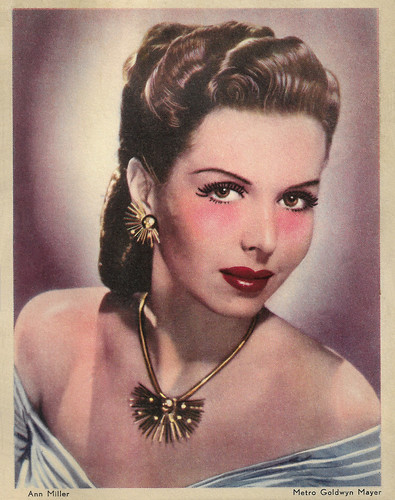
Vintage card. Photo: Metro-Goldwyn-Mayer.
A girl named Johnnie
Ann Miller was born Johnnie Lucille Ann Collier in 1923 on her grandparent's ranch in Chireno, Texas. Her father wanted a boy, so Ann was named Johnnie, and she later went by Lucille. Her father was a well-known criminal lawyer who had defended famous gangsters Bonnie and Clyde and Baby Face Nelson. Mrs. Collier enrolled her three-year-old little girl in dancing lessons to help strengthen her legs, which had become weakened from a case of rickets.
When Lucille was ten she met Bill 'Bojangles' Robinson at a local theatre and he gave her a quick tap-dancing lesson. She liked that style of dance very much and decided to concentrate on it with further lessons. After her parents divorced, she went with her mother to Hollywood, determined to get into show business. The eleven-year-old brunette, pretending to be of legal age, was soon hired to dance for $25 a week at the Sunset Club, a small lounge where gambling went on upstairs.
Using the stage name of Ann Miller, she practiced her machine-gun tapping for the thrilled patrons. She also danced at the seedy Black Cat Club, where she scooped up the coins customers threw into her skirt to help pay the bills. Before long, Ann was netting unbilled extra roles as a schoolgirl in the films Anne of Green Gables (George Nichols Jr., 1934) and The Good Fairy (William Wyler, 1935), and she got to dance in The Devil On Horseback (Crane Wilbur, 1936).
The next year the thirteen-year-old was dancing for a four-month run in a show at the popular Bal Tabarin nightclub in San Francisco. There, she was discovered by comedian Benny Rubin and future comedian, actress Lucille Ball. Ball introduced Miller to executives at RKO Studios. Pretending she was eighteen with the help of a fake birth certificate supplied by her father, Ann landed a seven-year contract and a role in the film New Faces of 1937 (Leigh Jason, 1937).
Ann Miller's first great part was in Stage Door (Gregory La Cava, 1937), in which she danced with Ginger Rogers and acted with Lucille Ball, Katharine Hepburn, and Eve Arden. Other films in which Ann appeared include Radio City Revels (Benjamin Stoloff, 1937), the Oscar winner You Can't Take It With You (Frank Capra, 1938) with Jean Arthur and James Stewart, and Room Service (William A. Seiter, 1938) with the Marx Brothers.
Miller introduced Lucille Ball to Desi Arnaz, and, some years later, the famous couple bought RKO and re-named it Desilu. Ann's last film at the studio was Too Many Girls (George Abbott, 1940), in which she co-starred with friends Lucy and Desi. She then appeared on Broadway in George White's 'Scandals' in 1939 and 1940, for which she won rave reviews.
In 1940 Miller moved to Republic Pictures, where she enlivened Melody Ranch (Joseph Santley, 1940) with Gene Autry in his first musical film, and Hit Parade of 1941 (John H. Auer, 1941). Other films followed, many aimed at promoting the war effort, including True To The Army (Albert S. Rogell, 1942), Priorities On Parade (Albert S. Rogell, 1942), Reveille With Beverly (Charles Barton, 1943), What's Buzzin', Cousin? (Charles Barton, 1943), Hey Rookie (Charles Barton, 1944), and Jam Session (Charles Barton, 1944).
In 1945, Ann briefly dated powerful MGM boss Louis B. Mayer. When the much older mogul asked Ann to marry him, she turned him down. Moaning and groaning to her on the phone, the dramatic Mayer swallowed sleeping pills and immediately sent his chauffeur to summon Ann to his death bed. An ambulance arrived first and he recovered. Later, Ann married Reese Milner, a rich steel heir, and they lived on the biggest ranch in California where they raised prized Hereford cattle. The marriage ended quickly after Reese threw Ann down the stairs of their home. Pregnant Miller filed for divorce from her hospital bed, with her broken back in a steel harness. Her baby, Mary, died a few hours after birth. Later, painfully returning to Mayer for a job, he told her, "If you'd married me, none of this would have happened."
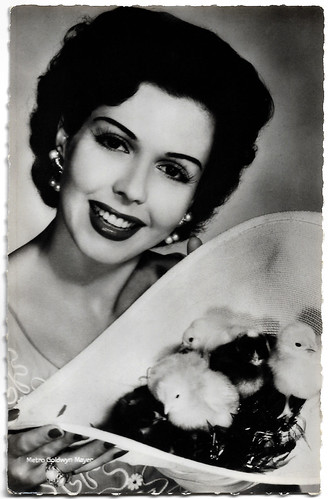
French postcard by Editions du Globe, no. 480. Photo: Metro-Goldwyn-Mayer.

Vintage postcard. Photo: Metro-Goldwyn-Mayer.

Vintage postcard, no. A.X. 292. Photo: Metro-Goldwyn-Mayer.
Spectacular and sometimes extravagant Technicolor musicals
Ann Miller was still in a back brace when she danced to 'Shakin' The Blues Away' in Easter Parade (Charles Walters, 1948), co-starring Fred Astaire and Judy Garland. She received fantastic reviews, and MGM gave Ann a seven-year contract. She then proceeded to make her most spectacular Technicolor musicals including On The Town (Stanley Donen, Gene Kelly, 1949), Small Town Girl (László Kardos, 1952) with Jane Powell, Kiss Me Kate (George Sidney, 1953) which was extravagantly filmed in 3-D, and Hit The Deck (Roy Rowland, 1955) with Debbie Reynolds.
Her last musical was a musical remake of The Women (George Cukor, 1939), named The Opposite Sex (David Miller, 1956), starring June Allyson. The glamorous, outgoing, and articulate Ann was also hired as MGM's Good Will Ambassador. She travelled the world in gorgeous designer ensembles while representing her studio with personal appearances and speaking engagements. When she flew to Morocco in July of 1957 to appear with Bob Hope on the Timex TV Hour, she entertained five thousand troops in 120-degree weather as she sang 'Too Darn Hot', and soon set a record for the world's fastest tap-dancing at 500 taps a minute.
In 1958, Miller married her second millionaire, Texas oilman Bill Moss who, she quipped, "...looked exactly like my first husband. Three months later, he broke my arm." A third marriage to another oilman, Arthur Cameron, was annulled within a year, though they remained friends. From 1966-1970, Ann became a hit on Broadway in 'Mame'. In 1970 she turned to television and starred in a commercial for Heinz's Great American Soups, in which Miller tap-danced on an eight-foot can of soup surrounded by dozens of high-kicking chorus girls, 20-foot fountains, and a 24- piece orchestra. Then, tapping her way back into her kitchen, her husband cried, "Why must you make such a big production out of everything?" The song she sang was written by humorist Stan Freberg and choreographed by Danny Daniels.
In 1972, in St. Louis, on the opening night of the musical show 'Anything Goes', Ann was knocked in the head by the steel beam of a fire curtain. Although as a consequence she was unable to walk for two years and suffered permanent vertigo, her life actually had been saved by her well-known, stiff, enormous, lacquered black wig. In 1979, she made a comeback and a fortune in 'Sugar Babies' with former teenage Hollywood acting schoolmate Mickey Rooney. The popular show ran for two years on Broadway and seven more years on the road. In 1998 she appeared in a successful revival of Stephen Sondheim's 'Follies' at the Paper Mill Playhouse in New Jersey.
In 1972, Miller published her autobiography, 'Miller's High Life', and more memoirs in 1981 with 'Tops In Taps'. Her last screen appearance was playing Coco in director David Lynch's critically acclaimed Mulholland Drive (2001). Ann Miller died of lung cancer in Los Angeles, California in 2004. She was buried next to her miscarried daughter, which reads "Beloved Baby Daughter Mary Milner November 12, 1946". The Smithsonian Institution displays her favourite pair of tap shoes, which she playfully nicknamed 'Moe and Joe'.
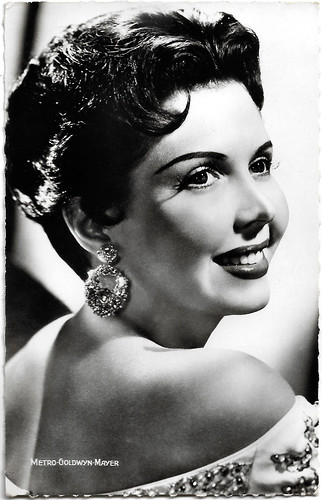
French postcard by Editions du Globe, no. 522. Photo: Metro-Goldwyn-Mayer.

Vintage postcard. Photo: Metro Goldwyn Mayer. Collection: Carla Bosch.
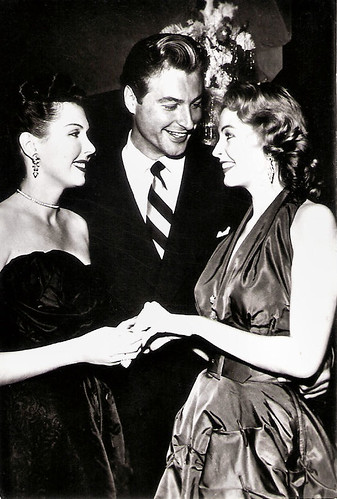
Belgian collectors card. Photo: M.G.M. Lex Barker, Ann Miller and Arlene Dahl.

French postcard by Editions P.I., Paris no 427, 1952. Photo: Metro-Goldwyn-Mayer.
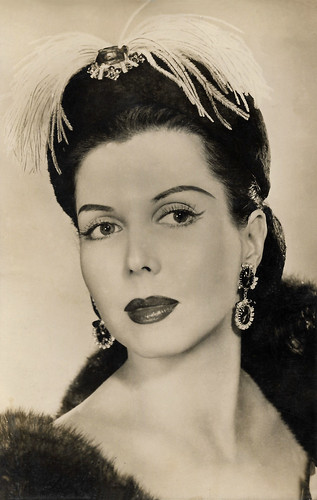
Spanish postcard, no. 2872.
Sources: Steve Starr (The Entertainment Magazine), Wikipedia (Dutch and English), and IMDb.
No comments:
Post a Comment